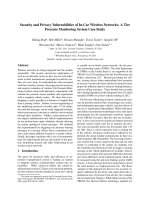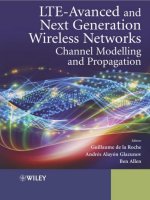Special Issue on ‘‘Mobile Ad-Hoc Wireless Networks
Bạn đang xem bản rút gọn của tài liệu. Xem và tải ngay bản đầy đủ của tài liệu tại đây (322.4 KB, 4 trang )
������������������������������������������������������������������������������������������������������������������������������������������������������������������������������������������������������������������������������������������������������������������������������������������������������������������������������������������������������������������������������������������������������������������������������������������������������������������������������������������������������������������������������������������������������������������������������������������������������������������������������������������������������������������������������������������������������������������������������������������������������������������������������������������������������������������������������������������������������������������������������������������������������������������������������������������������������������������������������������������������������������������������������������������������������������������������������������������������������������������������������������������������������������������������������������������������������������������������������������������������������������������������������������������������������������������������������������������������������������������������������������������������������������������������������������������������������������������������������������������������������������������������������������������������������������������������������������������������������������������������������������������������������������������������������������������������������������������������������������������������������������������������������������������������������������������������������������������������������������������������������������������������������������������������������������������������������������������������������������������������������������������������������������������������������������������������������������������������������������������������������������������������������������������������������������������������������������������������������������������������������������������������������������������������������������������������������������������������������������������������������������������������������������������������������������������������������������������������������������������������������������������������������������������������������������������������������������������������������������������������������������������������������������������������������������������������������������������������������������������������������������������������������������������������������������������������������������������������������������������������������������������������������������������������������������������������������������������������������������������������������������������������������������������������������������������������������������������������������������������������������������������������������������������������������������������������������������������������������������������������������������������������������������������������������������������������������������������������������������������������������������������������������������������������������������������������������������������������������������������������������������������������������������������������������������������������������������������������������������������������������������������������������������������������������������������������������������������������������������������������������������������������������������������������������������������������������������������������������������������������������������������������������������������������������������������������������������������������������������������������������������������������������������������������������������������������������������������������������������������������������������������������������������������������������������������������������������������������������������������������������������������������������������������������������������������������������������������������������������������������������������������������������������������������������������������������������������������������������������������������������������������������������������������������������������������������������������������������������������������������������������������������������������������������������������������������������������������������������������������������������������������������������������������������������������������������������������������������������������������������������������������������������������������������������������������������������������������������������������������������������������������������������������������������������������������������������������������������������������������������������������������������������������������������������������������������������������������������������������������������������������������������������������������������������������������������������������������������������������������������������������������������������������������������������������������������������������������������������������������������������������������������������������������������������������������������������������������������������������������������������������������������������������������������������������������������������������������������������������������������������������������������������������������������������������������������������������������������������������������������������������������������������������������������������������������������������������������������������������������������������������������������������������������������������������������������������������������������������������������������������������������������������������������������������������������������������������������������������������������������������������������������������������������������������������������������������������������������������������������������������������������������������������������������������������������������������������������������������������������������������������������������������������������������������������������������������������������������������������������������������������������������������������������������������������������������������������������������������������������������������������������������������������������������������������������������������������������������������������������������������������������������������������������������������������������������������������������������������������������������������������������������������������������������������������������������������������������������������������������������������������������������������������������������������������������������������������������������������������������������������������������������������������������������������������������������������������������������������������������������������������������������������������������������������������������������������������������������������������������������������������������������������������������������������������������������������������������������������������������������������������������������������������������������������������������������������������������������������������������������������������������������������������������������������������������������������������������������������������������������������������������������������������������������������������������������������������������������������������������������������������������������������������������������������������������������������������������������������������������������������������������������������������������������������������������������������������������������������������������������������������������������������������������������������������������������������������������������������������������������������������������������������������������������������������������������������������������������������������������������������������������������������������������������������������������������������������������������������������������������������������������������������������������������������������������������������������������������������������������������������������������������������������������������������������������������������������������������������������������������������������������������������������������������������������������������������������������������������������������������������������������������������������������������������������������������������������������������������������������������������������������������������������������������������������������������������������������������������������������������������������������������������������������������������������������������������������������������������������������������������������������������������������������������������������������������������������������������������������������������������������������������������������������������������������������������������������������������������������������������������������������������������������������������������������������������������������������������������������������������������������������������������������������������������������������������������������������������������������������������������������������������������������������������������������������������������������������������������������������������������������������������������������������������������������������������������������������������������������������������������������������������������������������������������������������������������������������������������������������������������������������������������������������������������������������������������������������������������������������������������������������������������������������������������������������������������������������������������������������������������������������������������������������������������������������������������������������������������������������������������������������������������������������������������������������������������������������������������������������������������������������������������������������������������������������������������������������������������������������������������������������������������������������������������������������������������������������������������������������������������������������������������������������������������������������������������������������������������������������������������������������������������������������������������������������������������������������������������������������������������������������������������������������������������������������������������������������������������������������������������������������������������������������������������������������������������������������������������������������������������������������������������������������������������������������������������������������������������������������������������������������������������������������������������������������������������������������������������������������������������������������������������������������������������������������������������������������������������������������������������������������������������������������������������������������������������������������������������������������������������������������������������������������������������������������������������������������������������������������������������������������������������������������������������������������������������������������������������������������������������������������������������������������������������������������������������������������������������������������������������������������������������������������������������������������������������������������������������������������������������������������������������������������������������������������������������������������������������������������������������������������������������������������������������������������������������������������������������������������������������������������������������������������������t the
throughput varies depending on the access categories. When
comparing the throughput results from the tests with and that
of the tests without the hidden station effect, it was observed
that the throughput degrades for the RTS/CTS case when
compared with the Basic Access case. Hence, this paper extends earlier works by other authors dealing with IEEE
802.11e. The model presented applied the Markov chain model
for IEEE 802.11e under non-saturation conditions and effects
of the hidden stations. The results presented in the paper aim
to calculate the throughput versus the number of stations for
different access categories.
The fourth paper, Performance Evaluation of Neighbor Discovery in Proactive Routing Protocols, by Andres Medina and
Stephan Bohacek, provides a comprehensive study about the
performance evaluation of neighbor discovery mechanisms in
mobile ad-hoc networks. This paper develops a detailed performance model of neighbor discovery and shows that the degree
estimation agreed within a 5% error margin, with simulations.
This paper discusses Type I errors and Type II errors. A Type I
error occurs when a node believes that it has a neighbor when in
fact it is not able to communicate with it, while a Type II error
occurs when a node is unaware that it is able to communicate
with a node. The performance model developed in this paper
evaluates the average number of neighbors a node believes it
has, probability of type I and type II errors, the impact of
neighbor discovery on connectivity, and link flap rate.
First, the paper discusses neighbor discovery performance
model. The performance model is made up of three parts:
the radio model, the neighbor detection model, and the mobility model. The model proposed calculates the probability of error in a packet transmission over a link as a function of the
length of the link and the level of channel utilization in the network. Two types of neighbor detection schemes are discussed.
The first method is Event Driven Neighbor Detection (ED)
which is a generalization of the neighbor detection mechanism
(NDM). The second method is Exponential Moving Average
Neighbor Detection mechanism (EMA) which is thought to
be a method to enhance the robustness of link sensing. For
each NDM, a Markov Chain Model is used to model the state
of a link. A relative trajectory model is presented and is validated for two different mobility models, namely nodes moving
on a torus in fixed, but random, directions and random way
point mobility. The results of the simulation are very much
in line with the analytical results obtained. In addition, as
nodes move closer together, the probability that Hello messages are successfully received increases, thus increasing the
probability that the link is classified as symmetric. Also the
probability that a link is classified asymmetric not only depends on the current link loss probability, but also on the past
loss probability. More specifically, the probability that a link is
symmetric depends on the trajectory of the link loss probability, which in turn depends on the trajectory of the distance between the nodes. The paper then presents a mathematical
equation to determine the average number of symmetric links.
The analysis of the equations shows that speed has significance
on the number of symmetric links and the number of symmetric links decreases with congestion. The proposed model
achieves the smallest neighbor estimation errors. The paper
also addresses the issues of link flap by considering the rate
at which links go from non-symmetric to symmetric.
197
Hence, the authors conclude that for the performance evaluation of MANETs, consideration of neighbor discovery process is very important. This paper gives very good insight by
studying a wide range of behaviors including the average number of symmetric links, type I and type II errors in the neighbor
detection process, and the impact of neighbor discovery on
connectivity and link flap.
The fifth paper, ComboCoding: Combined Intra/InterFlow Network Coding for TCP over Disruptive MANETs
by Chien-Chia Chen, Clifford Chen, Soon Oh, Joon-Song
Park, Mario Gerla, and M. Yehia Sanadidi focuses on the efficient use of TCP in the lossy wireless network. The paper proposes Combo coding scheme which combines inter-flow and
intra-flow coding to provide an efficient use of TCP transmission in disorderly wireless networks. Previously proposed
schemes address either the ACK interference problem or the
high data loss problem but not both. This paper introduces a
hybrid network-coding scheme that is transparent to TCP. It
addresses both TCP interference and random loss issues which
are encountered during the transmission. Combo coding combines TCP DATA and ACK flows together within one hop
and relies on ACK-based redundancy control, which has high
overheads in disruptive networks. As TCP Data and TCP
ACK always travel in opposite direction, it causes interference
and introduces loss in multi-hop scenarios, which decreases
throughput. Additionally, it has no control overhead since
coding redundancy is based on loss rate estimates.
Combo Coding consists of two different types of network
coding; inter-flow coding and intra-flow coding. It combines
the concepts of Piggy Code and Pipeline coding. This paper refers to inter-flow coding as a modified version of Piggy Code,
and intra-flow coding as Pipeline Coding. The use of Pipeline
Coding reduces the overall coding delay and is used with adaptive redundancy to reduce high packet loss over non-reliable
links. It uses the concept of packet generations, encoding
and decoding progressively. On the other hand, Piggy Code
is a network-coding scheme designed to enhance TCP performance over IEEE 802.11 multi-hop wireless networks. Its main
goal is opportunistically XORing the TCP Data and TCP
ACK at intermediate node. This paper highlights four key concepts and features of Combo coding which are: (1) combining
inter- and intra-flows coding to address both high loss rate and
self-induced interference. (2) Using a novel loss adaptation
algorithm that effectively handles transient, unstable link conditions. (3) It is implemented in the network layer and is transparent to TCP and other upper layer protocols thus, making it
forward compatible with any future improvement of upper
layer protocols. (4) It does not rely on any new or modified
MAC layer protocols.
The paper then presents a detailed code flow chart, Loss
Adaptation Algorithm and channel access scheme to implement the combo coding. The proposed concepts are then tested
by running a simulation. The results show that by using the
3-hops topology, Combo Coding successfully achieves 2 Mbps
throughput with 30% per link packet loss rate. As compared
to the original Pipeline Coding, Combo Coding reduces transmission overhead by 30% under perfect link conditions and by
10% overhead in most other cases. Hence, it is concluded that
by using Combo coding in TCP over disruptive mobile ad-hoc
networks, we can achieve better communication results.
The sixth paper, Self Organization of Nodes in Mobile AdHoc Networks Using Evolutionary Games and Genetic
198
Algorithms by Janusz Kusyk, Cem S. Sahin, M. Umit Uyar,
Elkin Urrea, and Stephen Gundry, focuses on the critical issues
in mobile ad-hoc networks (MANETs) of the optimum organization of the nodes in a geographical area that gives the best
and maximum area coverage. This paper proposes a scheme in
which MANET nodes place themselves uniformly over a
dynamically changing environment in the absence of a centralized controller using a distributed and scalable evolutionary
game scheme. The main performance concerns of mobile adhoc networks (MANETs) are topology control, spectrum sharing and power consumption, all of which are intensified by the
lack of a centralized authority and a dynamic topology. This
paper aims to combine forced-based genetic algorithm
(FGA), Game theory (GT), and Evolutionary game theory
(EGT) to introduce a new approach for handling topology
control. The topology control in MANETs can be analyzed
from two different perspectives. In one approach, the goal is
to manage the configuration of a communication network by
establishing links among nodes already positioned in a terrain.
In the second approach, the relative and absolute locations of
the mobile nodes define the network topology.
In MANETs, for self organizing nodes, finding the best new
location for a node that satisfies certain requirements is very
difficult. Traditional search algorithms for such problems use
sampling or heuristically techniques that are not sufficient.
This paper introduces a scheme called node spreading evolutionary game (NSEG), which runs at each individual mobile
node. Each individual node in the proposed model asynchronously runs NSEG to make an autonomous decision about
its next location. NSEG provides a good solution for the node
spreading class of applications used by both military and commercial applications. In the proposed NSEG, every node computes its next preferable location independently without
requiring global network information. Every node independently makes movement decisions based on localized data.
Forced-based genetic algorithm (FGA) determines the movement probabilities of possible next locations. NSEG is a
two-step process that consists of first evaluating the player’s
current location and spatial game setup. After a player moves
to a new location, the node computes the integrity of its current location. Then, it runs FGA to determine a set of possible
next locations into which it can move. In spatial game setup, a
node decides to move to a new location by constructing its
payoff matrix with an entry for each possible strategy profile
that can arise among members. The goal of each node is to distribute itself over an unknown geographical terrain in order to
obtain a high coverage of the area by the nodes and to achieve
a uniform node distribution while keeping the network connected. Each node is aware of its own location and can determine the relative locations of its neighbors. Additionally, every
node assesses the fairness of its own location as well.
The proposed model was simulated using a test written in
the JAVA programming language. After running NSEG it
was observed that even in the early stages of the experiment,
the nodes were able to disperse far from their original locations
and were able to provide significant improvement of the area
coverage while keeping network connected. Hence NSEG,
combined with FGA and game theory, can find better future
locations for self-spreading autonomous nodes over an unknown geographical territory. The simulation results demonstrate that NSEG performs well with respect to network area
Editorial
coverage, uniform distribution of mobile nodes, and convergence speed.
The seventh paper, Efficient Content Distribution for Peerto-Peer Overlays on Mobile Ad-Hoc Networks by Afzal Mawji
and Hossam Hassanein, presents an efficient content distribution scheme. It utilizes network coding and multipoint-to-multipoint communication to provide an efficient means of
transferring files between peers in the network. This technique
can achieve reduced download times and energy consumption.
Peers request file blocks from multiple server nodes and server
nodes multicast blocks to multiple receivers, providing efficient
multipoint-to-multipoint communication. The peers who are
‘‘Client peers’’ are able to find server peers and download
coded blocks, which enables them to retrieve content in less
time than downloading un-coded blocks. Server peers transmit
data blocks via multicast to enable multiple client peers to
download simultaneously.
In a P2P file sharing system, most of the network traffic will
consist of the files being transferred through the network.
There is no centralized authority and no infrastructure in a
P2P–MANET. The proposed scheme uses linear network coding to eliminate the rarest–block problem and multicasting to
reduce the number of transmissions where possible. Network
coding is a form of information spreading in which nodes
use XOR operations to encode several packets together instead
of forwarding data packets. Network coding allows nodes to
obtain any blocks they could find from servers without worrying about locating specific blocks. Using network coding reduces the likelihood of sending/receiving duplicate data to/
from clients and server. One major benefit of network coding
is that encoded packets can be further encoded and can save
bandwidth. In addition, the use of multicasting enables the server peer to multicast its encoded blocks to several client peers.
Clients request a certain number of blocks from multiple servers depending on the cost of acquiring them and how many
blocks the servers have, resulting in multipoint-to-multipoint
communication. After getting the list of servers, block counts,
and hop distances, the client uses a greedy algorithm to determine from whom to download, and how many blocks to request from each server. Furthermore, multicasting blocks
allow servers to efficiently deliver data to multiple receivers
and reduce transmissions at the server node.
The concepts presented in the paper are then verified by running a test simulation. The performance of the presented
scheme was compared to downloading the entire file from a single seed, downloading blocks from multiple servers, and network coding without multicasting. It was shown that the
proposed scheme consumed less energy, provided speedier
downloads, and had a greater success rate than the competing
algorithms. Additionally it was a much fairer scheme as it allowed more peers to participate in the process for uploading
the blocks.
Tarek Nazir Saadawi
City University of New York, USA
E-mail:
Hussein Mouftah
University of Ottawa, USA
E-mail:









